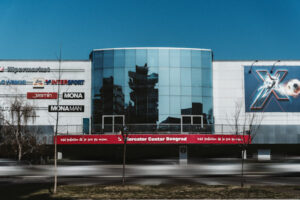ACROSS: What characteristics does a modern, contemporary shopping center have?
ÁRPÁD TÖRÖK: Nowadays, we speak much of “experience centers” rather than shopping centers—a place where entertainment, social life, and recreation must be provided in addition to shopping and in a creative and forward-looking way.
In recent years, several related, new trends have become visible in the market. Whereas in the past, the F&B offer covered only 3 to 4% of the overall profile mix, the current trend is for food and entertainment concepts to occupy approximately 15% of the total GLA.
This relatively new approach provides, for example, communal areas, co-working office spaces, medical services, and even cultural programs within retail locations. Hands-free shopping, in-house fashion stylists, interactive store concepts, home delivery, and click & collect points as extra services have also appeared in the past few years.
Central locations near the city center, where visitors have the option of taking care of several things at the same time in the same place (sightseeing, shopping etc.) are important. Besides comfort and time savings, easy accessibility is also appreciated, as is a catchment-focused tenant mix.
ACROSS: What makes one shopping center more successful than others?
TÖRÖK: The location, accessibility, proper tenant mix, right balance of profiles, and a wide range of services (shopping, service, entertainment, food) are all a must. A clear layout and attractive architectural solutions may also create added value.
Unique solutions are much more important nowadays, however—especially digital solutions. Virtuality is a magnet word and an important trend that is successfully reaching today’s consumers. For example, Westfield London has a virtual fitting room as a pop-up solution.
Personalized recommendations and real-time information using digital tools are also effective. A good example is the “shop in shop” Google store in London, with a virtual graffiti wall for its interactive window displays and a futuristic interior equipped with large screens.
ACROSS: Which three European shopping centers do you believe best meet these criteria?
TÖRÖK: Number one is Il Centro in Milan, Italy. It reflects a great architectural rehabilitation of the site, a tremendous building design with sustainable materials, large open areas, and huge glass surfaces and it follows the latest trends in the food market with a great variety of services.
Second is Westfield in London. It has a good location, it’s an innovative mall with a digital focus, VR fitting room, concierge service for hands-free shopping, and a great dining concept.
Third is Bonarka City Center Krakow, Poland. It boasts the latest digital solutions like an omnichannel platform (an integrated platform for management of pro-sales activities of the shopping mall—integration of all digital communication channels and pro-sales tools combined with loyalty program schemes) and has a good tenant mix, a CSR policy engaging locals, and is a good size.





